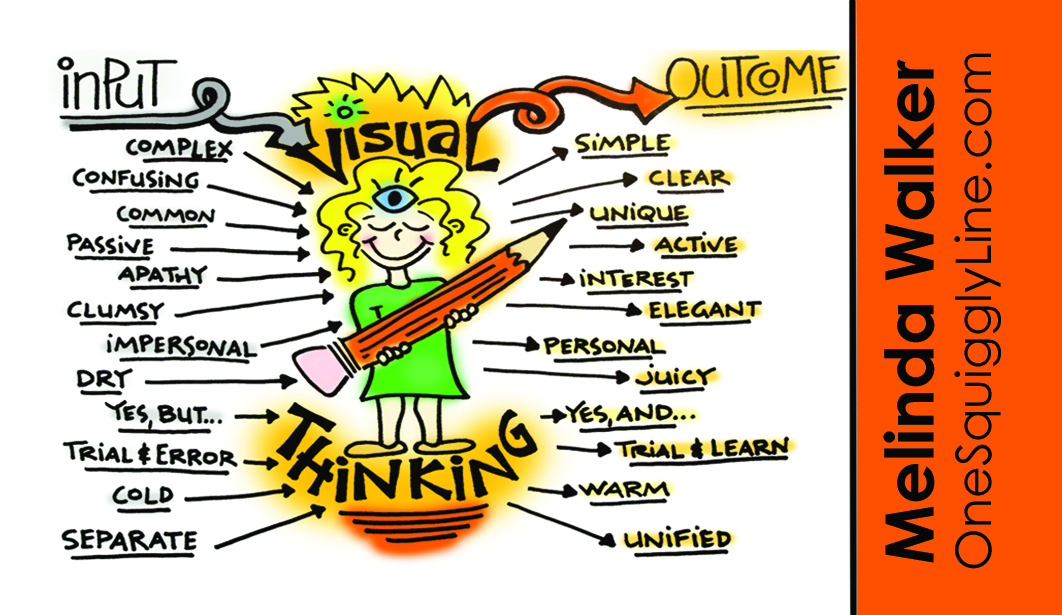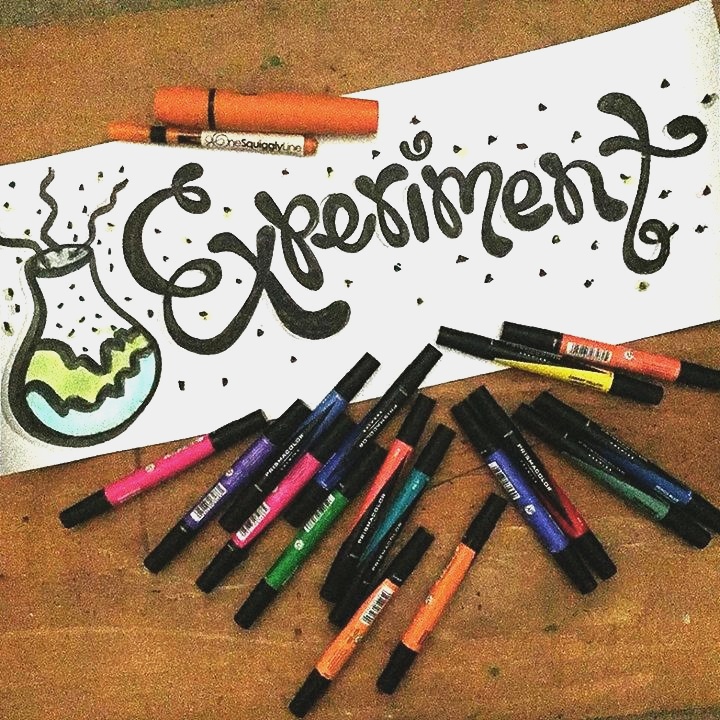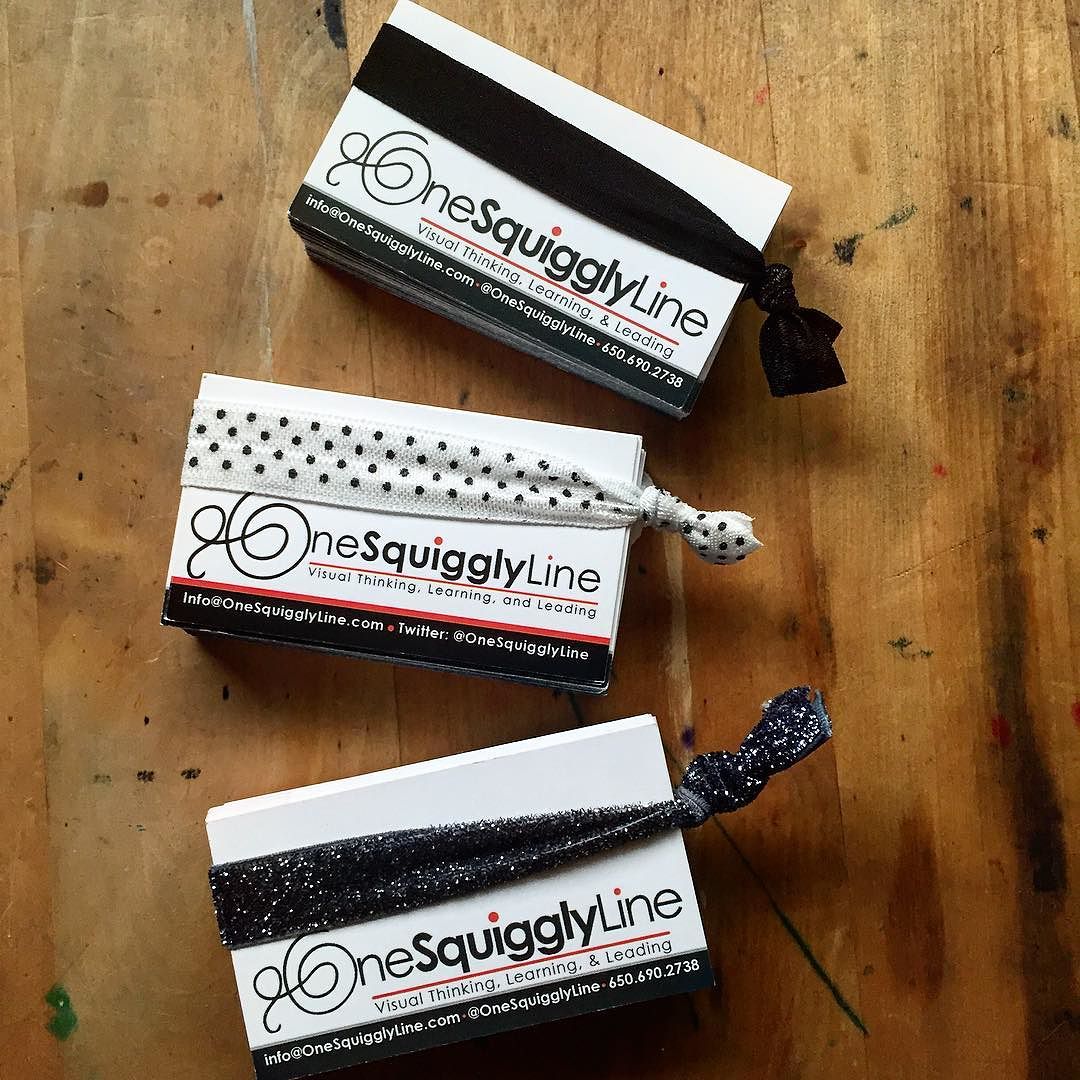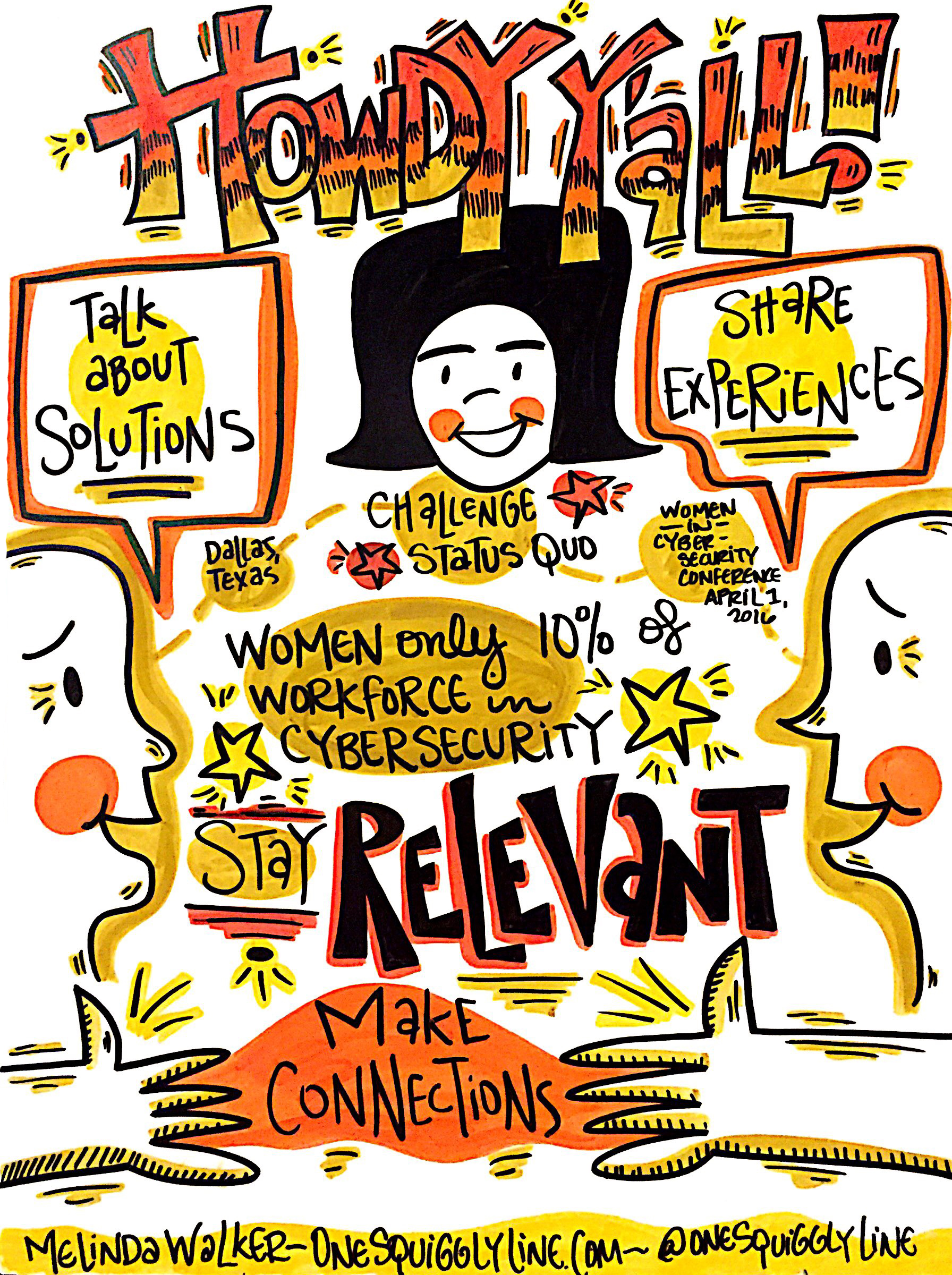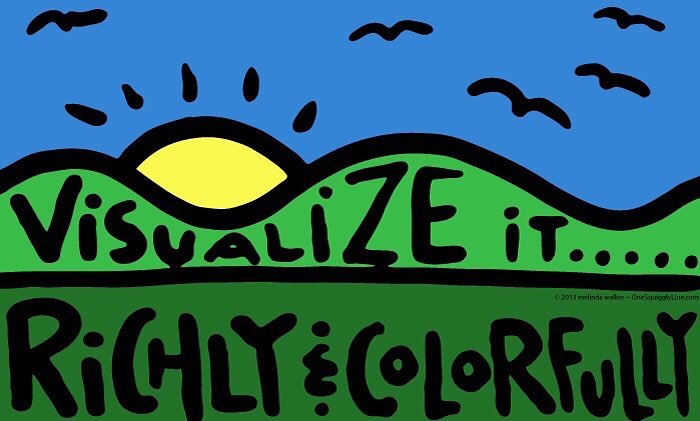When working live, you never know what's going to happen. I usually only have the same information the people in the audience have, which is a basic agenda. So I know the speaker's name, title of their talk, and how long they are scheduled to speak. That's it!
It's not uncommon for talks to go longer as planned, like the one above. That's usually a good sign, as it means the audience is really engaged. But it can be a challenge to capture all that extra content on the same page.
Color is a great way to keep things organized when there's not much space available. Grouping concepts and thoughts according to color allows you to have completely different ideas right next to each other without things getting confusing.
See more visual notes created live at One Squiggly Line's graphic recording page.
Visual Thinking: Words & Pictures Together
What grabbed your attention first — the image above or the big chunk of text below?
Odds are, the image grabbed your eye first. It's probably the main reason you're reading the text in the first place!So go back to the image for a minute.Really look at it. READ it.
Now, read the paragraph below:
Visual thinking makes complex information simple, brings clarity to confusing communication, makes the common unique, turns the passive into the active and apathy into interest. With visual thinking, the clumsy becomes elegant, the impersonal becomes personal, the dry becomes juicy, "Yes, but..." is replaced with "Yes, and...", trial and error turns to trial and learn, the cold becomes warm, and the separate become unified.
That paragraph and the accompanying image say the same thing!Most people find the information easier to absorb through the image than the paragraph.They're able to absorb that information faster and remember it longer. And, it's a lot more fun!
Check out One Squiggly Line'sAbout Visual Thinking page to learn more.
Creativity: Creative Combinations
Creativity
There's a myth out there that highly creative people just sit around and wait for inspiration to strike. Like a great big lightening bolt from the sky. Or a soft whisper from a mystical muse.
Truth is, creativity is not quite so passive. It is an active process. And there's a science to it, not just an art. There are even formulas, methods, and procedures for generating ideas and, equally importantly, evaluating them.
One classic way to create something new is to combine two things. Take the markers above, for example. Nothing new about a round tip marker. Or a brush tip marker. But when you put them both in one pen, you end up with a whole new product!
Learn More About Visual Thinking
Creativity: You ARE Creative
Many people don't consider themselves creative because they can’t “draw” or “paint”.
The reality is that creativity can take on a variety of forms - many forms beyond the physical realm. In fact, creativity starts and is born from our internal world. Our goal is to figure out which medium best portrays our personal creativity.
Thus, we must make sure we cultivate an environment that is conducive to creativity. But how do we do that? How do we know what that environment looks like? Isn’t it different for everyone?
Yes.
The first step, and the most important step, is to become more familiar with ourselves.
We must be able to recognize the types of things that stir our heart, set our soul on fire, and make us come alive. Because once we recognize them, then we can begin to replicate them.
And the only way to find out is by trying out a variety of different things, as creativity demands quantity.
“Don’t ask what the world needs. Ask what makes you come alive, and go do it. Because what the world needs is people who have come alive.”
-Howard Thurman
Learn More About Visual Thinking
Creativity: We All Have It — Reignite Yours!
Think back to when you were a kid. Do you remember your personality? Do you remember any quirks you had?
And if you can’t remember that far back, think about the little kids you know, whether family, friends, or even strangers.
They all have one thing in common - they’re at the the most creative stage in their life.
Children are at a stage where they haven’t been conditioned to many routines and norms. They are completely themselves - unfiltered and raw.
...Always asking why
...Not caring too much of what others think about their appearance or their actions
...Saying whatever comes to mind
...Not holding back any ounce of laughter
As we grow older, eventually we don’t question as much
Eventually the routines of life become mainstream
Eventually our imagination grows stale
We hold back our laughter more and more
And eventually we lose the perspective of what could be in exchange for what is
Creativity gets taught out of us
Our teachers telling us to write in 12 pt. Arial font.
Our parents not having enough patience to answer all of our why’s.
Our own inflicted judgements
We become afraid of failure. Of messing up. Of saying the wrong thing. Of being judged.
To the point where we’ve lost ourselves in exchange for a mask that society has handed us.
We have unlearned creativity.
We all have the ability to be creative, but it's our job to learn it again.
Visual thinking is a great way to jumpstart your creativity, whether personally or professionally, alone or with a group. Simply watching someone else create something can inspire creative thinking and actions. Contact me to bring the power of visuals to your next event, meeting, or project and reclaim your creativity!
Visual Thinking: Get it! Grab it! Go for it!
While visual thinking makes things simple, it certainly does not dumb them down. Part of the simplicity comes from removing unnecessary parts, leaving behind only what you need to work with. That allows you to really see exactly what it is you do have to work with. This often leads to that, "Oh, now I get it!" moment when everything finally seems to fall into place and make sense.
Once you can see things more clearly, you are able to make better decisions. Sometimes, things become so obvious it doesn't even really feel like you're making a decision at all. The right choice just jumps right at you. Or if you do need to think about it for a minute, it's much easier for you to grab it and run with it.
Check out One Squiggly Line's About Visual Thinking page to learn more.
Visual Thinking & Creativity: Use something in a new way
There's a myth out there that highly creative people just sit around and wait for inspiration to strike. Like a great big lightening bolt from the sky. Or a soft whisper from a mystical muse.
Truth is, creativity is not quite so passive. It is an active process. And there's a science to it, not just an art. There are even formulas, methods, and procedures for generating ideas and, equally importantly, evaluating them. One way to get a new idea or find a creative solution is to use something in a new way.
Sometimes, I take stacks of business cards with me, like if I'm working at a conference or event. Regular rubber bands seemed to rip several of the cards, which meant I had fewer to give out. So, I looked around and found something different to hold my business cards together — stretchy ribbon hair ties. Not only do they hold my business cards together, they look better, too!
When it comes to creativity, the best ideas can be inside the box, not outside of it. You just need to use them in a new way.
Visual Thinking & Visual Notes: Live Graphic Recording
Hand-drawn visuals are far friendlier than standardized fonts and stock photos. And hand-drawn visuals are even more inviting when created live, right there where everyone can see.
The drawing above was created during the opening remarks at the Women in Cyber Security conference the end of March. It was then displayed near registration to welcome late-comers. Not a high resolution file shown here, just taken with my iPhone in the moment.
To see the whole set of visual notes from the Women in Cyber Security conference, check out this Flickr album.
Visual Thinking & Creativity; Visualize it richly & colorfully
Visualizing things richly and colorfully leads to more creative thinking. You probably visualize things more than you realize, without really thinking about it. So you already have some visual thinking skills. But how do you become better at visualizing things on purpose?
Try this:
Go to a hardware store or someplace that sells paint. First, pick a paint sample color card that matches your shirt. That's a warm-up, starting with something very concrete and right in front of you — your shirt.
Then, look for a paint sample color card that matches something at home. It could be a different shirt, a piece of furniture, your walls. Whatever you choose, you will need to picture it very clearly in your mind so you can "see" the color.
Paint sample cards are usually free, so you can take home the ones you think are the closest and see how well you did. The more you practice, the better you get!
Check out One Squiggly Line's About Visual Thinking page to learn more.
Visual Thinking: Visual Biography
Abstract ideas can be fascinating, but our brains really prefer things to be concrete. That way, it's much easier for the brain to make sense of them. And remember them.
A great way to make your own short bio more memorable and engaging is to make it visual! Mine is above. As you can see, the key facts are worked into my logo. That helps folks remember a bit about me when they look at my logo, wherever it is.
A visual biography can be much more powerful than a paragraph or two listing your accomplishments. So if you need to give a quick bio for a speaking engagement or whatever, make it visual!
Check out One Squiggly Line's About Visual Thinking page to learn more.


